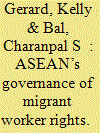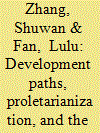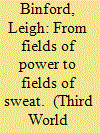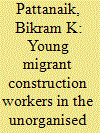|
|
|
Sort Order |
|
|
|
Items / Page
|
|
|
|
|
|
|
| Srl | Item |
| 1 |
ID:
157891


|
|
|
|
|
| Summary/Abstract |
Temporary migrant workers in Southeast Asia are subject to various abuses in recruitment, work and repatriation. A decade ago ASEAN governments committed to developing an Instrument governing migrant worker rights, but a series of deadlocks have stymied this agreement. Prevailing accounts explain this impasse as the consequence of incompatible national interests, norms of non-interference and consensus, a lack of institutional capacity and the limits of rights advocacy in ASEAN. Conversely, utilising a political economy framework, this article demonstrates this impasse in regional governance reflects societal-level conflicts among migrant workers, civil society organisations, business groups and state-based actors, generated by the latter’s adoption of migrant labour as both a livelihood and development strategy.
|
|
|
|
|
|
|
|
|
|
|
|
|
|
|
|
| 2 |
ID:
170979


|
|
|
|
|
| Summary/Abstract |
From the perspective of development, this article examines the power relations among local states, capital, and migrant laborers that shape the making of proletarians/semi-proletarians in two famous garment manufacturing areas, Humen in the Pearl River Delta and Pinghu in the Yangtze River Delta. It emphasizes the distinct forms of association in the daily production process of workers against the exploitation by capital and the control of states embedded in two different power relations. In Humen, a high proportion of external investment in the garment industry and lack of local authority regulatory resources, accompanied by highly mobile migrant workers without local hukous, undermines the foundation of daily association in production. Migrant workers generally work with subcontractors and "vote with their feet." In Pinghu, the historical heritage of collective economies enhances the control of local authorities over both labor and capital, which has led to the full proletarianization of garment industry workers. Meanwhile, embedding deeply in local communities empowers local workers to associate in cooperative production teams and negotiate with capitalists collectively, resulting in a relatively higher payback. Both forms of imperceptible daily struggles generate transformation of labor institutions in the two areas.
|
|
|
|
|
|
|
|
|
|
|
|
|
|
|
|
| 3 |
ID:
087023


|
|
|
|
|
| Publication |
2009.
|
| Summary/Abstract |
This article examines the social construction of migrant labour forces through an analysis of the exterior and interior conditioning in an agricultural contract labour programme between Mexico and Canada. I argue that forms of exterior conditioning, especially employers' point-of-production control, establishes the context within which migrant workers' experience unfolds, for which reason it contributes to their 'interior conditioning'. But I argue as well that the result is shaped by workers' employment of a 'dual frame of reference' through which they gauge Canadian wages and working conditions the only way they can, which is in relationship to Mexican ones. Given that neoliberal policies have reduced the options available in Mexico, and diminished the attractiveness of those that remain, contract labour in Canada presents one of the few opportunities many poor, rural Mexicans have to acquire the income necessary for a minimally dignified life. Consequently most workers in this programme do everything possible to please their employers and continue in the programme.
|
|
|
|
|
|
|
|
|
|
|
|
|
|
|
|
| 4 |
ID:
087509


|
|
|
|
|
| Publication |
2009.
|
| Summary/Abstract |
This article constitutes an empirical socio-economic analysis based on a field study involving 1200 young unorganised workers found in the construction sector of the so-called tri-city of Chandigarh, Panchkula and Mohali. The main aim of the study was to examine the reasons why and how these young people had come to work in this urban environment, how they live and spend their money and what they perceive as their major problems. Based on the findings, the article argues that Indian policy makers, with specific regard to the urban unorganised labour sector, should take more-adequate measures for the protection of human rights of such migrant workers.
|
|
|
|
|
|
|
|
|
|
|
|
|
|
|
|
|
|
|
|
|